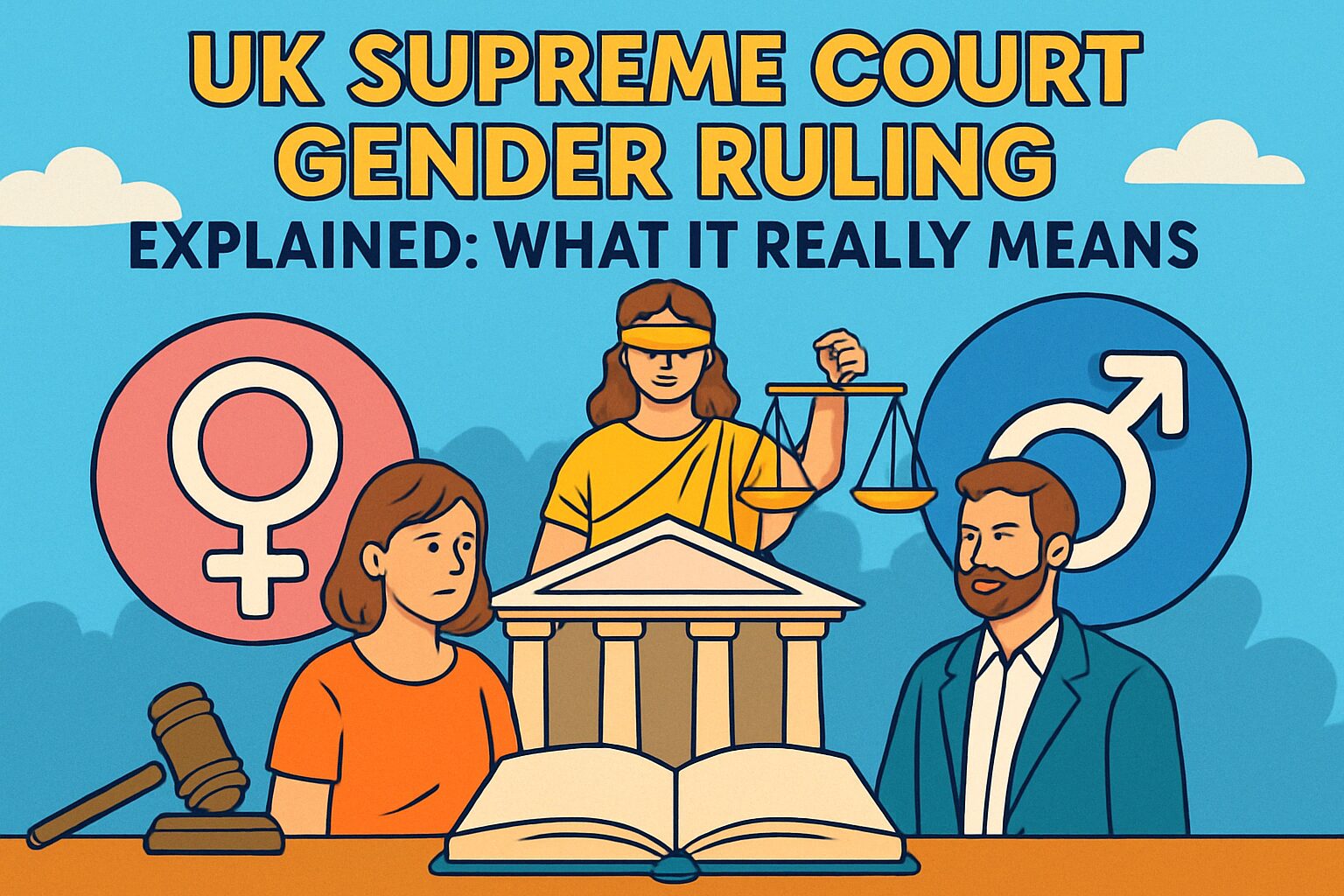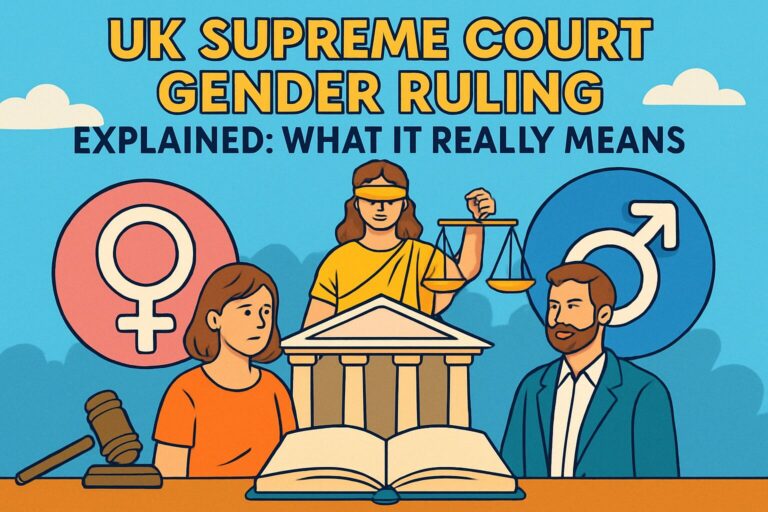UK Supreme Court Gender Ruling Explained: What It Really Means
UK Supreme Court Gender Ruling Explained: What It Really Means
The UK gender ruling, made on 16 April 2025, has sparked major discussion about how we define “woman” in law. This new Supreme Court decision focuses on biological sex rather than gender identity. In simple terms, it affects how sex-based rights are applied under the Equality Act. It also explains how laws should treat single-sex services, sports categories, and data collection.
This topic also has a simplified version available for younger learners, here. UK Gender Ruling Explained for Young People
This ruling came from a legal case in Scotland involving the definition of “woman” in public appointments. The court decided that legal definitions in UK law must refer to biological sex, not gender identity. That means some policies will now treat transgender women differently from biological women in certain situations. However, transgender people still have full protection under existing anti-discrimination laws.
This guide helps you understand what the UK gender ruling actually means — and why it matters. It explains the key terms, the legal background, and what this decision might change in everyday life. Whether you agree with the judgment or not, it’s important to know what’s changed and why. Clear facts can help us think critically and have better conversations.
What Was the UK Gender Ruling About?
The UK gender ruling refers to a 2025 Supreme Court case that clarified how the word “woman” should be understood in UK law. Specifically, it said that for the purpose of the Equality Act 2010, “woman” means biological female, not someone who identifies as female. This case involved the Scottish Government’s attempt to include transgender women with Gender Recognition Certificates (GRCs) in public board quotas for women.
The court ruled that doing so conflicted with the original legal meaning of the word “woman” under the Equality Act. That law was written to protect people based on sex and gender reassignment, but it didn’t redefine sex itself. The Supreme Court stated that adding new meanings to “woman” would make other parts of the law confusing or contradictory.
In short, the ruling confirmed that where the law says “woman,” it refers to someone born biologically female. It does not mean anyone who identifies as female, even if they have changed legal documents. That’s a big legal shift — and one with wide-reaching effects.
This decision has caused strong reactions from both sides of the debate. That’s why it’s worth breaking down exactly what it does and doesn’t say.
Why Did the Court Make This Decision?
The Supreme Court wasn’t trying to make a political statement. Instead, it focused on how the law is written and how words like “sex” and “woman” are used in legal documents. Their job was to check if Scotland’s law fitted with UK-wide laws — especially the Equality Act 2010.
The court decided that changing the definition of “woman” would cause legal problems. For example, if a “woman” includes people who are biologically male, it could affect laws about equal pay, women’s safety, or women-only services. These laws rely on the idea that sex is a biological category.
That doesn’t mean the court rejected transgender rights. It simply said they’re protected in different ways — through the characteristic of “gender reassignment,” not by changing what “sex” means. It was a legal interpretation, not a moral judgment.
The judges also said it’s Parliament’s job to change definitions in law, not the courts. That means any change to the meaning of sex would need a new law passed by MPs, not just a new interpretation by local governments.
What Does ‘Biological Sex’ Mean in Law?
In science, biological sex is based on physical and genetic traits — things like chromosomes, hormones, and reproductive organs. In UK law, biological sex refers to the sex you’re recorded as at birth. This matters because many legal protections and rights are based on sex, not identity.
The Equality Act 2010 protects people from discrimination based on both sex and gender reassignment. But these are treated as separate characteristics. This ruling confirms that sex-based protections are based on biological sex only — not how someone identifies or what’s written on their gender certificate.
It’s like building a house with separate rooms. One room is for sex, the other is for gender reassignment. You can’t merge the two into one space without changing the design — which only Parliament can do.
This means that a transgender woman with a GRC is legally female in some ways — like on a passport — but not in terms of sex-based rights under the Equality Act. It’s a complex legal line, but the ruling made that line clearer.
How Does This Affect Sports?
Sport is one of the clearest areas where sex matters. In many sports, men and women compete separately because of physical differences. The ruling supports the idea that women’s sports can legally exclude people who are biologically male — even if they identify as female.
This is already allowed under the Equality Act in situations where safety or fairness is at stake. The court’s decision confirms that these rules still apply. It gives sports bodies more confidence to create clear policies based on sex rather than gender identity.
That doesn’t mean all transgender people will be excluded from sport. Some may still be able to compete in mixed categories or create new ones. But single-sex sports can now be protected more easily under law.
The key point is that sports organisations now have a clear legal reason to separate categories by sex — not identity — if needed for fairness or safety.
What About Single-Sex Services?
Single-sex services include places like women’s refuges, changing rooms, or rape crisis centres. The Equality Act already allows these services to exclude people of the opposite sex when it’s a proportionate and necessary step — for safety, privacy, or dignity.
Before the ruling, there was confusion about whether “woman” included transgender women in all cases. Some organisations were afraid to set boundaries in case they were breaking the law. The court clarified that these services can lawfully restrict access to biological women only, if they have good reason.
It’s important to note that this doesn’t mean discrimination is allowed. Transgender people are still protected — but the law now gives more room to balance their rights with the rights of biological women.
This ruling empowers service providers to make clearer, lawful choices — without fear of legal action for sticking to sex-based categories.
What Happens in Schools and Prisons?
The ruling affects institutions like schools and prisons too. These are places where sex-based policies can be important — for example, in housing, toilets, changing areas, or safety policies.
Now that sex means biological sex in law, public bodies may review their policies. For example, a female prison may restrict access to biological women only, even if a transgender woman has a Gender Recognition Certificate. That’s already happening in some places — and this ruling gives it a stronger legal basis.
In schools, it could affect how policies around single-sex spaces, sports teams, and safeguarding are written. It won’t erase trans rights — but it does strengthen the right of public institutions to set clear sex-based rules when justified.
This area will likely keep evolving as more legal cases and policies are developed. But the ruling gives a starting point for clarity in places where safety and fairness are priorities.
Does This Change Transgender Rights?
No. Trans people in the UK are still protected by law under the characteristic of “gender reassignment.” They can’t be harassed, bullied, or denied services just because they’re trans.
What’s changed is how rights are balanced. Before, there was confusion about whether being legally female (with a GRC) meant being treated the same as someone born female in all situations. Now, the court says: not always.
That means a transgender woman may be recognised as female on documents, but still excluded from some sex-based services — depending on the situation. It’s not a total rejection of transgender identity, but a clearer separation of sex and gender in law.
It’s a difficult balance. Many people feel this ruling is necessary for women’s rights. Others worry it may lead to more exclusion of transgender people. What matters is that both groups still have legal protections — and we need to handle these differences carefully.
How Might This Affect Daily Life?
If you’re not in politics, law, or activism, you might wonder if this ruling affects you at all. It might — especially if you work in healthcare, education, prisons, sports, or charities. These sectors often deal with questions about single-sex spaces or data collection.
Organisations may now change how they record sex and gender. For example, a survey might ask for “biological sex” rather than “gender identity.” That helps create clearer data for things like health research or crime reporting.
It could also affect job applications, equal pay comparisons, or rules about who qualifies for certain roles on public boards. In most everyday situations, though, it’s about policies — not personal identity.
What the ruling does is create more space for organisations to make lawful choices based on sex, without fear of legal confusion.
What Are People Saying About the Ruling?
Reactions have been mixed. Women’s rights groups welcomed the ruling as a return to clear definitions and better protection for sex-based services. They argue that biological sex matters in many areas of life — and that ignoring it can harm women’s rights.
Trans advocacy groups, however, worry that the decision may lead to more exclusion and misunderstanding. They say it could send a message that trans women are less valid or visible in society. The legal change, while limited, may feel personal.
Politicians, journalists, and legal experts are now debating what comes next. Should Parliament review the Equality Act? Should new categories be added? These are big questions for the future.
The ruling doesn’t end the conversation — but it does shift how that conversation is framed. It asks us all to think about how we define fairness, inclusion, and truth.
A Final Thought
The UK gender ruling has made one thing very clear: words in law matter. Whether you agree or disagree with the outcome, it’s a reminder that definitions shape rights — and getting them right matters for everyone.
Related Wikipedia Links
To explore further, you can check the official records and background of the case here:
What Do You Think?
Do you think sex and gender should be treated the same in law? What might be the benefits or downsides of this decision? How should rights be balanced when people’s needs clash?

